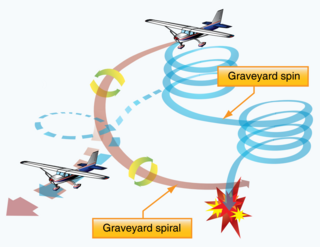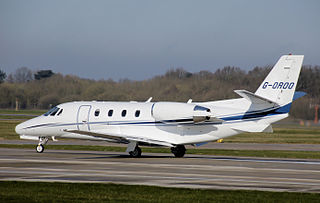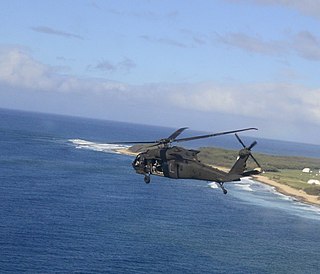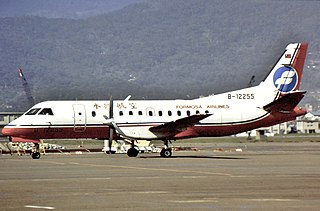Related Research Articles

In aviation, instrument flight rules (IFR) is one of two sets of regulations governing all aspects of civil aviation aircraft operations; the other is visual flight rules (VFR).
In aviation, visual flight rules (VFR) are a set of regulations under which a pilot operates an aircraft in weather conditions generally clear enough to allow the pilot to see where the aircraft is going. Specifically, the weather must be better than basic VFR weather minima, i.e., in visual meteorological conditions (VMC), as specified in the rules of the relevant aviation authority. The pilot must be able to operate the aircraft with visual reference to the ground, and by visually avoiding obstructions and other aircraft.

Westchester County Airport is a county-owned airport in Westchester County, New York, three miles (6 km) northeast of downtown White Plains, with territory in the towns of North Castle and Harrison, New York, and village of Rye Brook, New York. It is sometimes referred to as the White Plains Airport and is so identified by the Official Airline Guide (OAG).
Instrument rating refers to the qualifications that a pilot must have in order to fly under instrument flight rules (IFR). It requires specific training and instruction beyond what is required for a private pilot certificate or commercial pilot certificate, including rules and procedures specific to instrument flying, additional instruction in meteorology, and more intensive training in flight solely by reference to instruments.
Spatial disorientation is the inability to determine position or relative motion, commonly occurring during periods of challenging visibility, since vision is the dominant sense for orientation. The auditory system, vestibular system, and proprioceptive system collectively work to coordinate movement with balance, and can also create illusory nonvisual sensations, resulting in spatial disorientation in the absence of strong visual cues.
In general aviation, scud running is a practice in which pilots lower their altitude to avoid clouds or instrument meteorological conditions (IMC). The goal of scud running is to stay clear of weather to continue flying with visual, rather than instrument, references. This practice is widely accepted to be dangerous, and has led to death in many cases from pilots flying into terrain or obstacles, such as masts and towers, normally referred to as controlled flight into terrain, or CFIT; however, even instrument-rated pilots sometimes elect to take the risk to avoid icing or embedded thunderstorms in cloud, or in situations where the minimum instrument altitudes are too high for their aircraft.

In aviation, instrument meteorological conditions (IMC) are weather conditions that require pilots to fly primarily by reference to flight instruments, and therefore under instrument flight rules (IFR), as opposed to flying by outside visual references under visual flight rules (VFR). Typically, this means flying in cloud or poor weather, where little or nothing can be seen or recognised when looking out of the window. Simulated IMC can be achieved for training purposes by wearing view-limiting devices, which restrict outside vision and force the trainee to rely on instrument indications only.
Pilot licensing or certification refers to permits for operating aircraft. Flight crew licences are issued by the civil aviation authority of each country, which must establish that the holder has met minimum knowledge and experience before issuing licences. The licence, along with the required class or type rating, allows a pilot to fly aircraft registered in the licence issuing state.
An instrument rating is an authorization required for a pilot to fly under instrument flight rules (IFR). In the United States, the rating is issued by the Federal Aviation Administration.

Human senses are not naturally geared for the inflight environment. Pilots may experience disorientation and loss of perspective, creating illusions that range from false horizons to sensory conflict with instrument readings or the misjudging of altitude over water.
VFR over-the-top (OTT) refers to flying over top of clouds in visual flight, rather than with reference to instruments. This is usually done for brief amount of time to avoid weather or turbulence.
Taos Regional Airport is a public use airport eight nautical miles (15 km) northwest of the central business district of Taos, in Taos County, New Mexico, United States. It is owned by the Town of Taos. FAA's National Plan of Integrated Airport Systems for 2009–2013 classifies it as a general aviation airport.

In aviation, a graveyard spiral is a type of dangerous spiral dive entered into accidentally by a pilot who is not trained or not proficient in flying in instrument meteorological conditions (IMC). Other names for this phenomenon include suicide spiral, deadly spiral, death spiral and vicious spiral.

John F. Kennedy Jr., the son and namesake of the former U.S. President John F. Kennedy, died when the light aircraft he was flying crashed into the Atlantic Ocean off Martha's Vineyard, Massachusetts, on July 16, 1999. Kennedy's wife Carolyn Bessette and sister-in-law Lauren Bessette were also on board and died. The Piper Saratoga departed from New Jersey's Essex County Airport; its intended route was along the coastline of Connecticut and across Rhode Island Sound to Martha's Vineyard Airport.

On 13 August 2014, a Cessna Citation Excel business jet crashed while trying to land at Santos Air Force Base, near Santos, Brazil, killing all seven people on board. Among the victims was Brazilian Socialist Party presidential candidate Eduardo Campos. Eleven people on the ground were also injured. The accident investigation concluded that spatial disorientation in poor weather and pilot fatigue likely caused a low altitude loss of control of the aircraft, leading to the impact with the ground.

On March 10, 2015, a Sikorsky UH-60 Black Hawk helicopter of the United States Army crashed off the coast of the Florida Panhandle during a training exercise at Eglin Air Force Base, killing all eleven people on board. The helicopter was reported missing during foggy conditions at 8:30 PM. The helicopter was assigned to the 1-244th Assault Helicopter Battalion, based in Hammond, Louisiana.

On March 5, 1963, American country music performers Patsy Cline, Cowboy Copas, and Hawkshaw Hawkins were killed in an airplane crash near Camden, Tennessee, United States, along with the pilot Randy Hughes. The accident occurred as the three artists were returning home to Nashville, Tennessee, after performing in Kansas City, Kansas.

Atlas Air Flight 3591 was a scheduled domestic cargo flight under the Amazon Air banner between Miami International Airport and George Bush Intercontinental Airport in Houston. On February 23, 2019, the Boeing 767-375ER(BCF) used for this flight crashed into Trinity Bay during approach into Houston, killing the two crew members and single passenger on board. The accident occurred near Anahuac, Texas, east of Houston, shortly before 12:45 CST (18:45 UTC). This was the first fatal crash of a Boeing 767 freighter.

On 29 May 2021, a Cessna 501 Citation I/SP crashed into the Percy Priest Lake in Tennessee. All seven occupants died, including diet guru Gwen Shamblin Lara and her husband, actor Joe Lara.

Formosa Airlines Flight 7623 was a domestic flight from Hsinchu to Kaohsiung. It crashed into the ocean shortly after take-off in a severe right bank.
References
- ↑ Ison, David (February 6, 2016). "Understanding VFR Into IMC Accidents". AOPA. Retrieved 11 February 2021.
- ↑ "Training Fact Sheet – Inadvertent Entry Into Instrument Meteorological Conditions (IIMC)" (PDF).
Inadvertent entry into IMC is a situation where deteriorating weather prevents you from flying under visual meteorological conditions when you were planning to fly under VFR.
- 1 2 3 4 Rowland, David (February 5, 2017). "Surviving VFR into IMC". AV Web. Retrieved 26 February 2021.
- ↑ LeCompte, Tom (September 2008). "The Disorient Express". Air & Space. Retrieved 26 February 2021.
- ↑ Ison, David (February 6, 2016). "Understanding VFR Into IMC Accidents". Plane & Pilot. Retrieved 26 February 2021.
- 1 2 3 Aulls Bryan, Leslie; Stonecipher, Jesse W.; Aron, Karl (1954). 180-degree turn experiment. University of Illinois. ASIN B0007EXGMI. LCCN a54009717. OCLC 4736008. OL 207786M.
- ↑ "178 Seconds to Live" (PDF). Federal Aviation Administration. Retrieved 26 February 2021.
- ↑ Dubois, William E. (February 4, 2016). "The lost lessons of '178 seconds to live'". P&E: Proficiency [blog]. Aircraft Owners & Pilots Association. Retrieved 26 February 2021.
- ↑ Durfee, James R.; Gurney, Chan; Denny, Harmar D.; Minetti, G. Joseph; Hector, Louis J. (September 23, 1959). Aircraft Accident Report (PDF) (Report). Civil Aeronautics Board. Archived from the original (PDF) on February 26, 2009. Retrieved February 4, 2009.
- ↑ "Rapid Descent Into Terrain, Island Express Helicopters Inc., Sikorsky S-76B, N72EX, Calabasas, California, January 26, 2020" (PDF). National Transportation Safety Board. 2021-02-09. NTSB/AAR-21/01. Retrieved 2021-02-26.